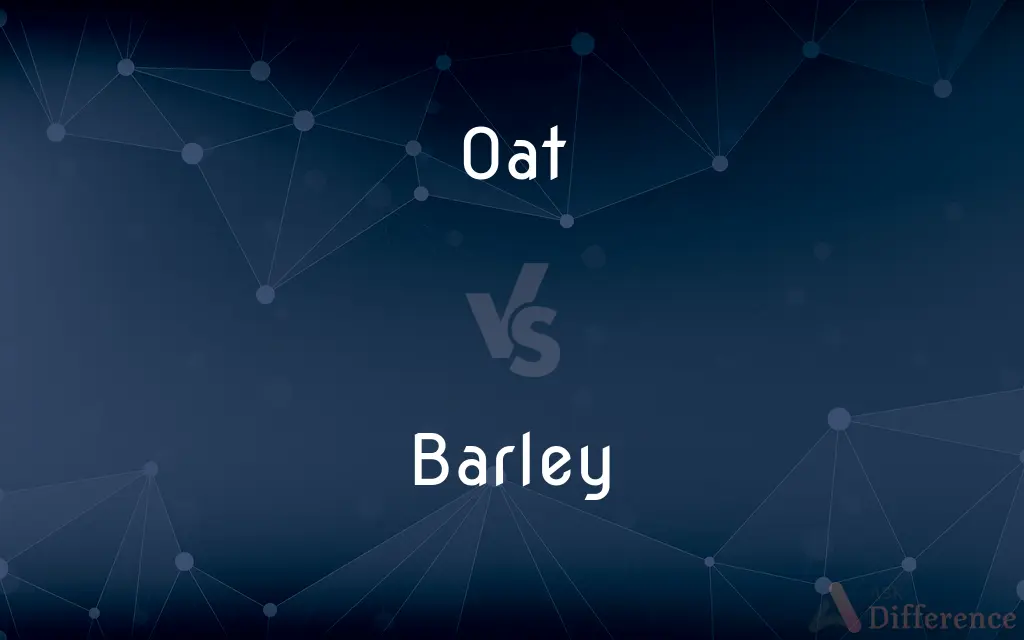Oat vs. Barley — What's the Difference?
By Tayyaba Rehman — Updated on September 19, 2023
Oats are grains often processed into rolled or steel-cut forms for consumption, while barley is a cereal grain with a nuttier flavor, commonly used in soups and brewing.

Difference Between Oat and Barley
Table of Contents
ADVERTISEMENT
Key Differences
Oat is a cereal grain that's particularly recognized for its nutritious profile. It's a primary source for oatmeal, which is a popular breakfast choice. Given its health benefits, including its fiber content, oat consumption can support heart health and regulate blood sugar.
On the other hand, barley is one of the oldest consumed grains in the world. It possesses a slightly chewy texture and a nutty flavor. Barley has applications that span from food to beverages. For instance, it's a fundamental ingredient in making malt for brewing beer.
When contrasting oat and barley, their culinary uses become evident. While oats predominantly find their way into porridges, cereals, and baking, barley is often an ingredient in stews, soups, and beverages like beer. Both grains, however, are nutrient-rich, offering a range of health benefits.
The physical appearance of oat and barley grains also differentiates them. Oats are generally flatter and longer, while barley grains tend to be shorter and more rounded. Additionally, while both are used in animal feed, their nutritional profiles differ slightly.
In terms of cultural significance, both oat and barley have historical roots. Oats have Celtic and Germanic origins, while barley's history is intertwined with ancient civilizations like the Egyptians and Sumerians. Over time, the cultivation and consumption patterns of these grains have evolved, yet their importance remains undiminished.
ADVERTISEMENT
Comparison Chart
Primary Use
Breakfast cereals, baking
Soups, stews, brewing
Texture
Softer when cooked
Chewy
Flavor
Mild
Nuttier
Appearance
Flatter, longer grains
Shorter, rounded grains
Nutritional Benefit
Rich in fiber, supports heart health
Rich in vitamins, aids digestion
Compare with Definitions
Oat
A cereal grain used primarily for food and fodder.
I added some oat grains to my morning smoothie.
Barley
Possesses a chewy texture and nutty flavor.
The barley soup was both hearty and flavorful.
Oat
The seed of the oat plant.
The oat harvest was bountiful this year.
Barley
Often used in brewing and distilling processes.
The brewery sources its barley from local farms.
Oat
A source of dietary fiber and energy.
Consuming oat regularly can improve digestion.
Barley
A cereal grain with a rich history of consumption.
Barley has been consumed for thousands of years.
Oat
Processed forms include rolled or steel-cut.
I made a warm bowl of steel-cut oat porridge.
Barley
Can be pearled to remove the outer hull.
Pearled barley cooks faster than its hulled counterpart.
Oat
A primary ingredient in breakfast cereals.
She prefers oat cereal over cornflakes.
Barley
A nutritious grain aiding in digestion.
Including barley in your diet can have health benefits.
Oat
The oat (Avena sativa), sometimes called the common oat, is a species of cereal grain grown for its seed, which is known by the same name (usually in the plural, unlike other cereals and pseudocereals). While oats are suitable for human consumption as oatmeal and rolled oats, one of the most common uses is as livestock feed.
Barley
Barley (Hordeum vulgare), a member of the grass family, is a major cereal grain grown in temperate climates globally. It was one of the first cultivated grains, particularly in Eurasia as early as 10,000 years ago.
Oat
An Old World cereal plant with a loose, branched cluster of florets, cultivated in cool climates and widely used for animal feed.
Barley
A hardy cereal with coarse bristles extending from the ears, cultivated especially for use in brewing and stockfeed.
Oat
An oat stem used as a musical pipe by shepherds, especially in pastoral or bucolic poetry.
Barley
A grass in the genus Hordeum native to temperate regions, having flowers in terminal, often long-awned spikes and widely cultivated for its grain.
Oat
Any of various grasses of the genus Avena, especially A. sativa, widely cultivated for their edible grains.
Barley
The grain of H. vulgare or its varieties, used in malt production and as food for livestock and humans.
Oat
The grain of any of these plants, used as food and fodder.
Barley
A cereal of the species Hordeum vulgare, or its grains, often used as food or to make beer and other malted drinks.
Oat
A musical pipe made of an oat straw.
Barley
(Singapore) seed of Job's tears Coix lacryma-jobi
Oat
(uncountable) Widely cultivated cereal grass, typically Avena sativa.
The oat stalks made good straw.
The main forms of oat are meal and bran.
World trade in oat is increasing.
Barley
A valuable grain, of the family of grasses, genus Hordeum, used for food, and for making malt, from which are prepared beer, ale, and whisky.
Oat
(countable) Any of the numerous species, varieties, or cultivars of any of several similar grain plants in genus Avena.
The wild red oat is thought to be the ancestor of modern food oats.
Barley
A grain of barley
Oat
The seeds of the oat, a grain, harvested as a food crop.
Barley
Cultivated since prehistoric times; grown for forage and grain
Oat
A simple musical pipe made of oat-straw.
Oat
The tiniest amount; a whit or jot.
Oat
A well-known cereal grass (Avena sativa), and its edible grain, used as food and fodder; - commonly used in the plural and in a collective sense.
Oat
A musical pipe made of oat straw.
Oat
Annual grass of Europe and North Africa; grains used as food and fodder (referred to primarily in the plural: `oats')
Oat
Seed of the annual grass Avena sativa (spoken of primarily in the plural as `oats')
Common Curiosities
Is barley good for brewing?
Yes, barley is a primary grain used in malting for brewing beer.
Is barley water beneficial?
Yes, barley water is often consumed for its digestive benefits.
Are oats gluten-free?
Pure oats are gluten-free, but they might be cross-contaminated with gluten grains during processing.
Can I replace oats with barley in recipes?
While they have different textures, they can be substituted in some recipes but expect a change in flavor and texture.
Why are oats considered heart-healthy?
Oats contain beta-glucans, a type of fiber known to lower cholesterol.
Which is more protein-rich, oat or barley?
Both grains contain protein, but oats typically have slightly more.
What's the difference between hulled and pearled barley?
Hulled barley retains its bran and germ, while pearled barley is processed to remove these parts.
Do oats grow in the same conditions as barley?
Both can grow in similar climates, but their specific requirements might vary.
Can barley be eaten raw?
No, barley should be cooked before consumption.
Are oats used in animal feed?
Yes, oats are commonly used in feed for horses and other animals.
Share Your Discovery

Previous Comparison
Indefinite vs. Infinite
Next Comparison
Hill vs. KnollAuthor Spotlight
Written by
Tayyaba RehmanTayyaba Rehman is a distinguished writer, currently serving as a primary contributor to askdifference.com. As a researcher in semantics and etymology, Tayyaba's passion for the complexity of languages and their distinctions has found a perfect home on the platform. Tayyaba delves into the intricacies of language, distinguishing between commonly confused words and phrases, thereby providing clarity for readers worldwide.














































